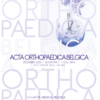Modular uncemented revision total hip arthroplasty in young versus elderly patients: a good alternative?
revision; hip; arthroplasty; complication rate; long-term
Published online: Feb 17 2023
Abstract
For revision hip arthroplasty, both cemented and cementless techniques have been described for implantation of modular and non-modular implants. Although many articles have been published on non-modular prosthesis, there is a dearth of data on cementless, modular revision arthroplasty in young patients. This study aims to analyze the complication rate of modular tapered stems in young patients below 65 years of age as compared to elderly patients older than 85 years old, in order to predict the complication rate. A retrospective study was performed using a major revision hip arthroplasty center database. Inclusion criteria consisted of patients undergoing modular, cementless revision total hip arthroplasties. Data on demographics, functional outcome, intraoperative, early and medium term complications were assessed. In total, 42 patients met inclusion criteria (<65 years old: 25 patients; >85 years old: 17 patients). For the <65 years old cohort, the mean age and follow-up time was 55.4 ± 9.3 years old and 13.3 ± 13.2 months, respectively. For the >85 years old cohort, the mean age and follow-up time was 87.6 ± 2.1 years old and 4.3±8.8 years, respectively. For intraoperative and short-term complications, no significant differences were observed. Medium term complication is noted in 23.8% (n=10/42) overall, preferentially affecting the elderly group at 41.2% (only 12.0% in the younger cohort; p=0.029). To our knowledge, this study is the first to investigate the complication rate and implant survival for modular revision hip arthroplasty based on age group. It shows that the complication rate is significantly lower in young patients and age should be a consideration in surgical decision making
